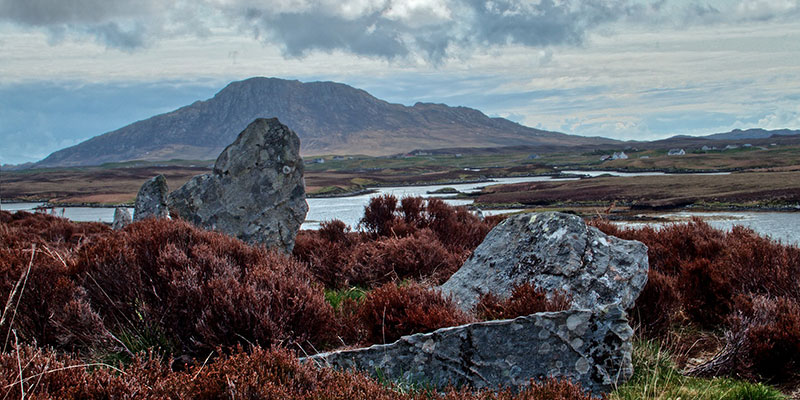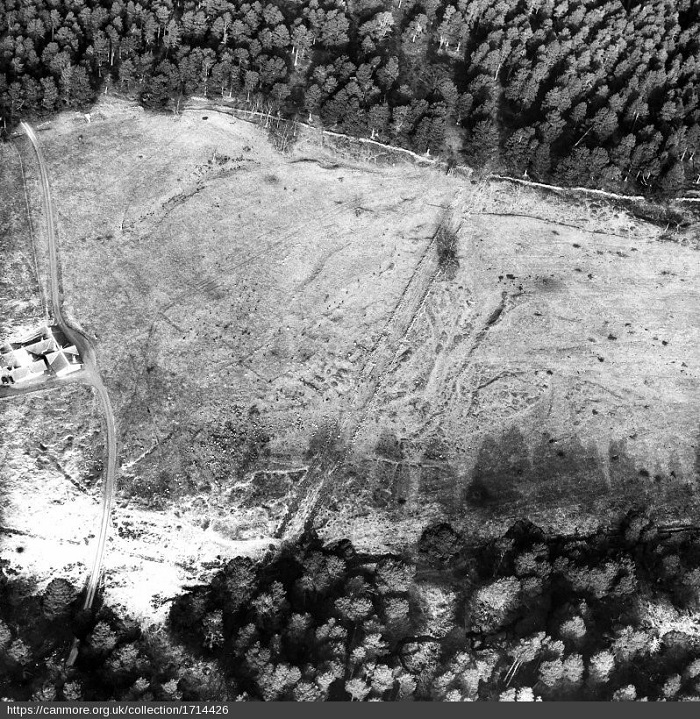An Archaeological Perspective on Rewilding
Michael Stratigos illustrates how Archaeology provides an important perspective in addressing what rewilding actually means and how it could be implemented.

Last month saw delivery of an open letter to the Royal Family calling on them to rewild their estates across the UK. The signatories were a diverse group, ranging from an Oscar Award winning actor to TV chefs to professors of biology, among many other diverse backgrounds. The concept of rewilding has been a controversial and slippery topic in ecology conservation for 30 years now. Rewilding is often touted as our best chance to tackle the dual challenges in the Anthropocene of a rapidly changing climate and dramatic loss of biodiversity. This may be the case, but what does rewilding actually mean? And how would it be implemented? It is way beyond this blog post to provide anything approaching definitive answers to these questions, but here I hope to illustrate that Archaeology provides an important perspective in addressing them.
The mantle of rewilding has been taken on especially by environmental activists with ever greater calls for land and sea to be returned to ‘nature’ - like the letter to Queen Elizabeth II. In that letter, there is some specificity on what exactly is to be done to achieve rewilding - they suggest ‘relinquishing’ land of poorer agricultural potential on Royal Estates to ‘self-willed wilderness, or managed for low intervention habitat restoration’. This is reasonable detail in a 1000 word letter given recent research has suggested that ‘rewilding’ as a conservation concept is not well defined especially as it relates to its goals - Shulte to Bühne et al. 2021. My own reading on the topic identifies that the fundamental commonality in rewilding is that no or minimal anthropogenic influence be exerted over certain areas informed by a sense of the past when this used to be the case - the ‘re’ in rewilding. This runs into conceptual problems for an archaeologist.
The implication that there was a ‘before’ in which no anthropogenic influence existed is simply not the case for most of the globe over at least the last 12,000 years (Elis et al. 2021). Maybe rewilding advocates are thinking of Pleistocene periods from even earlier where all human activity was pre-agricultural? This may be reasonable, but hunter-gatherers, fishers and foragers all have had substantial impacts on their environments. Perhaps rewilders are suggesting that areas operate in ways before modern humans and our close ancestors and relatives spread around the globe beginning some several million years ago? Again, this may be reasonable, but ignores how in the intervening years humans have shaped and continue to shape many of the fundamental processes of the ‘wild’ environment -- something archaeology has unique insight on. Some argue that the point of rewilding is not some end state, but rather allowing the processes of nature to occur without human interference. Yet, the understanding of what constitutes no human interference in natural processes still requires an imagined state (and the ‘re’ in rewilding firmly places that in the past) that has not really ever existed -- is it natural if we specifically set it aside in contrast to other places? In the open letter, it is quite clear that only poor agricultural land on Royal Estates is called to be rewilded, and other campaigns have similarly positioned rewilding as a non-threat to agricultural business. In short, from an archaeological perspective, there isn’t a before to return to.

A stand of Scots pine in Deeside, Aberdeenshire. CC-BY Michael Stratigos
More problematically, many examples of a before to which advocates for rewilding call to return are often themselves deeply anthropogenic - in some cases minimising the presence of people who lived there and usually left ample historic and/or archaeological remains to attest to their ways of life and relationships to their environments. This oversight is seen in the open letter when the signatories point out examples of rare surviving temperate rainforest of mostly Scots pine at Ballochbuie on the Balmoral Estate in Aberdeenshire, Scotland. This land contains archaeological remains of post-medieval (between c. AD 1600-1800) settlement and agriculture, both arable and pastoral. I’d suspect that further archaeological remains attesting to significant past human exploitation would be found in the forest if it were intensely surveyed - to my knowledge no such survey has ever been carried out beyond that in the clearing pictured below. Significant areas of woodland have undoubtedly formed part of this mixed agricultural landscape through the post-medieval period. While Ballochbuie strikes (and struck) a contrast to nearby upland areas relatively intensively grazed, there is little question that this woodland was also part of an exploited human settled landscape, probably continuously (or nearly so) since the Mesolithic period 10,000 years ago. Further archaeological remains in the Ballochbuie forest includes a very substantial carriage drive built in the 19th century over the earlier post-medieval agricultural remains, which belies the key reason for this woodland’s survival in its present form - the pursuit by Queen Victoria of the idealised ‘Highland’ landscape at the Balmoral Estate.

Queen Victoria’s Carriage Drive through the post-medieval settlement and agriculture remains surrounded by the Ballochbuie Forest -- © RCAHMS https://canmore.org.uk/collection/1714426
Ballochbuie’s history also highlights the means by which rewilding is achieved - certainly in the UK so far. It requires a landowner to make a decision to ‘relinquish’ land for this purpose. It might be argued Queen Victoria did this in 1868 when she acquired Ballochbuie which at the time was being logged (and probably had been substantially exploited for timber for many decades and more likely centuries before this). To date in the UK, rewilding has followed this paradigm of landowner decision-making, and indeed the open letter is calling for precisely this from Queen Victoria’s great granddaughter and great-great grandson. The key factor in this process which archaeology can throw light on is the history of land-use dictated by landowners - rewilding in the UK still relies upon it.
As it happens, this is not the first time in the history of Britain that massive landscape re-organisation of land-use has been called for and enacted. Indeed, the landscape of the UK we are familiar with geometric enclosed fields, stands of woodland, drained lowlands and barren heather-clad upland is in greater part defined by changes which took place in the 18th and 19th century - the Improvement period (see Tarlow 2007). Almost no square metre of Britain was untouched by this period’s radical changes in the imposition of field enclosures, drainage, land tenures, development of crop rotations and manuring practices among many other reforms and developments, virtually all under the direction and say-so of landowners. This transformation took place during a broader final shift toward capitalist marketisation of agricultural production at most levels and was informed by a moral sense of order and righteousness that these changes were necessary and correct. Archaeology (alongside History) has been a key tool in understanding the physical manifestation of that process in the landscape, and it is frequently the changes made during the Improvement period which are sought to be directly reversed by habitat restorers and rewilding advocates (e.g. river re-meandering).
While often these ‘Improvements’ were carried out by and with support from tenants, this process was frequently contentious, and even violent in the most extreme cases - famously in the clearances of the Sutherland Estate in Scotland in the early 19th century. That process by which a moral imperative informs sweeping land-use decisions echoes some examples of rewilding which were conceived and executed by landowners with little or no inclusion of local people (and their economic activities) in decision making to prioritise biodiversity. We can see this in some of the early attempts by individuals such as billionaire Anders Holch Polvsen, Scotland’s largest single landowner, who has pursued rewilding across his estates at Glenfeshie and Eriboll (among a number of others - he owns around 890 km2 in Scotland, approximately 1% of the total land area of the country). Increasingly, corporations have begun to use rewilding campaigns in the UK as marketing strategies and perhaps as forward thinking initiatives to a time when carbon and biodiversity offsetting are legally enforced or strongly encouraged via direct payments/subsidies - for example BrewDog.
There is no doubt that the kinds of ecology and conservation which fall under the umbrella of rewilding are absolutely necessary and can be incredibly effective at improving a range of ecosystem services. Indeed, a number of archaeologists have highlighted how the archaeological record might help inform the types of biodiversity and natural processes which should be reinstated by rewilding campaigns (See Buckland 1993 or Hambrecht et al. 2020). But from the perspective of this archaeologist (and others such as Caroline Wickham-Jones), there are some notes of caution worth highlighting. First, is that what is pursued by rewilding is never a past state, it is something entirely new. It can be informed by archaeology, palaeoecology and history of the past, but from its name to the way it is frequently spoken about by advocates, rewilding positions itself as an inherently nostalgic process. That risks mis-selling what it does, but perhaps more concerning, rewilding uses that sense of the past as a moral imperative - nature used to be this correct way, now we must return nature to the way it was. When coupled with the deep entanglement rewilding has with ownership (and especially ownership of large tracts of land like those owned by the Royal Family), rewilding in the UK may make many of the same mistakes of the 18th and 19th century Improvements in disenfranchising people from decision making about land-use in an unjust manner.
Rewilding is an anthropogenic solution to anthropogenic problems, inspiration about human-environment relationships is to be found in the archaeological record, but they can’t (and shouldn’t) be replicated in the present and future. To attempt to do so will more likely look like the 19th century than 19,000 BC.
Related links
Find out more about Michael Stratigos' research.
Related links
Find out more about Michael Stratigos' research.